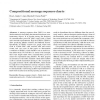Free Online Productivity Tools
i2Speak
i2Symbol
i2OCR
iTex2Img
iWeb2Print
iWeb2Shot
i2Type
iPdf2Split
iPdf2Merge
i2Bopomofo
i2Arabic
i2Style
i2Image
i2PDF
iLatex2Rtf
Sci2ools
TACAS
2001
Springer
2001
Springer
Compositional Message Sequence Charts
Abstract. A message sequence chart (MSC) is a standard notation for describing the interaction between communicating objects. It is popular among the designers of communication protocols. MSCs enjoy both a visual and a textual representation. High-level MSCs (HMSCs) allow specifying infinite scenarios and different choices. Specifically, an HMSC consists of a graph, where each node is a finite MSC with matched send and receive events, and vice versa. In this paper we demonstrate a weakness of HMSCs, which disallows one to model certain interactions. We will show, by means of an example, that some simple finite state communication protocol cannot be represented using HMSCs. We then propose an extension to the MSC standard which allows HMSC nodes to include unmatched messages. The corresponding graph notation will be called HCMSC, which stands for high-level Compositional message sequence charts. With the extended framework, we provide an algorithm for automatically constructing an ...
Related Content
| Added | 30 Jul 2010 |
| Updated | 30 Jul 2010 |
| Type | Conference |
| Year | 2001 |
| Where | TACAS |
| Authors | Elsa L. Gunter, Anca Muscholl, Doron Peled |
Comments (0)

